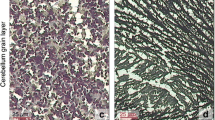Abstract
Tissue quality control measures are routinely performed in brain banks with the assessment of brain pH being the most common measure. In some brain banks the assessment of the RNA integrity number is also performed, although this requires access to specialised equipment and is more expensive. The aim of this study is to determine if there is a correlation between the visual assessment of cerebellar granule cell integrity and brain pH or RIN. One hundred and five consecutive cases from the NSW Tissue Resource Centre, Sydney, Australia were accessed. The cerebrum was hemisected and one hemisphere sliced parasagittally at approximately 1–2 cm intervals and frozen. The other hemisphere was fixed in 15% buffered formalin for 2–3 weeks. The contralateral cerebellar hemisphere was preserved in the same manner as the cerebral hemisphere. Samples of fixed tissue were embedded in paraffin, 7 μm sections cut and stained routinely with hematoxylin and eosin. The granular cell layer (GCL) was assessed microscopically to determine the degree of autolytic degradation. Degradation was graded as nil, mild, moderate or severe. Brain tissue pH and RIN were measured using standardised protocols. This study showed that both brain pH and RIN significantly correlated with the severity of the degradation of the cerebellar granule cell layer. This additional screening tool can be performed during routine histological review of the cerebellar tissue to assess the suitability for further investigation of tissue quality.


Similar content being viewed by others
References
Albrechtsen R (1977a) Naphthylamidase used as a lysosome marker in the study of acute selective necrosis of the internal granular layer of cerebellum. Acta Pathol et Microbiol Scand 85:875–888
Albrechtsen R (1977b) The pathogenesis of acute selective necrosis of the granular layer of the human cerebellar cortex. Acta Neuropathol Berl 37:31–34
Averback P (1980) A study of the rate of cell depletion in solid tissue. J Pathol 130:173–178
Harrison PJ, Heath PR, Eastwood SL, Burnet PW, McDonald B, Pearson RC (1995) The relative importance of premortem acidosis and postmortem interval for human brain gene expression studies: selective mRNA vulnerability and comparison with their encoded proteins. Neurosci Lett 200:151–154
Ikuta F, Hirano A, Zimmerman HM (1963) An experimental study of post-mortem alterations in the granular layer of the cerebellar cortex. J Neuropathol Exp Neurol 22:581–593
Jolles J, Bothmer J, Markerink M, Ravid R (1992) Phosphatidylinositol kinase is reduced in Alzheimer’s disease. J Neurochem 58:2326–2329
Kingsbury AE, Foster OJ, Nisbet AP, Cairns N, Bray L, Eve DJ, Lees AJ, Marsden CD (1995) Tissue pH as an indicator of mRNA preservation in human post-mortem brain. Brain Res Mol Brain Res 28:311–318
Li JZ, Vawter MP, Walsh DM, Tomita H, Evans SJ, Choudary PV, Lopez JF, Avelar A, Shokoohi V, Chung T, Mesarwi O, Jones EG, Watson SJ, Akil H, Bunney WE Jr, Myers RM (2004) Systematic changes in gene expression in postmortem human brains associated with tissue pH and terminal medical conditions. Hum Mol Genet 13:609–616
Mexal S, Berger R, Adams CE, Ross RG, Freedman R, Leonard S (2006) Brain pH has a significant impact on human postmortem hippocampal gene expression profiles. Brain Res 1106:1–11
Miller CL, Diglisic S, Leister F, Webster M, Yolken RH (2004) Evaluating RNA status for RT-PCR in extracts of postmortem human brain tissue. Biotechniques 36:628–633
Monoranu CM, Apfelbacher M, Grunblatt E, Puppe B, Alafuzoff I, Ferrer I, Al-Saraj S, Keyvani K, Schmitt A, Falkai P, Schittenhelm J, Halliday G, Kril J, Harper C, McLean C, Riederer P, Roggendorf W (2009) pH measurement as quality control on human post mortem brain tissue: a study of the BrainNet Europe consortium. Neuropathol Appl Neurobiol 35:329–337
Ogata J, Yutani C, Imakita M, Ueda H, Waki R, Ogawa M, Yamaguchi T, Sawada T, Kikuchi H (1986) Autolysis of the granular layer of the cerebellar cortex in brain death. Acta Neuropathol 70:75–78
Schroeder A, Mueller O, Stocker S, Salowsky R, Leiber M, Gassmann M, Lightfoot S, Menzel W, Granzow M, Ragg T (2006) The RIN: an RNA integrity number for assigning integrity values to RNA measurements. BMC Mol Biol 7:3
Sheedy D, Garrick T, Dedova I, Hunt C, Miller R, Sundqvist N, Harper C (2008) An Australian brain bank: a critical investment with a high return. Cell Tissue Bank 9:205–216
Stan AD, Ghose S, Gao XM, Roberts RC, Lewis-Amezcua K, Hatanpaa KJ, Tamminga CA (2006) Human postmortem tissue: what quality markers matter? Brain Res 1123:1–11
Tomita H, Vawter MP, Walsh DM, Evans SJ, Choudary PV, Li J, Overman KM, Atz ME, Myers RM, Jones EG, Watson SJ, Akil H, Bunney WE Jr (2004) Effect of agonal and postmortem factors on gene expression profile: quality control in microarray analyses of postmortem human brain. Biol Psychiatry 55:346–352
Webster MJ (2006) Tissue preparation and banking. Prog Brain Res 158:3–14
Weickert CS, Sheedy D, Rothmond DA, Dedova I, Fung S, Garrick T, Wong J, Harding AJ, Sivagnanansundaram S, Hunt C, Duncan C, Sundqvist N, Tsai SY, Anand J, Draganic D, Harper C (2010) Selection of reference gene expression in a schizophrenia brain cohort. Aust NZ J Psychiatry 44:59–70
Weis S, Llenos IC, Dulay JR, Elashoff M, Martinez-Murillo F, Miller CL (2007) Quality control for microarray analysis of human brain samples: the impact of postmortem factors, RNA characteristics, and histopathology. J Neurosci Methods 165:198–209
Acknowledgments
The NSW TRC is supported by the University of Sydney, National Health and Medical Research Council of Australia (605210), Schizophrenia Research Institute, and the National Institute of Alcohol Abuse and Alcoholism (R24AA012725).
Author information
Authors and Affiliations
Corresponding author
Rights and permissions
About this article
Cite this article
Sheedy, D., Harding, A., Say, M. et al. Histological assessment of cerebellar granule cell layer in postmortem brain; a useful marker of tissue integrity?. Cell Tissue Bank 13, 521–527 (2012). https://doi.org/10.1007/s10561-011-9265-1
Received:
Accepted:
Published:
Issue Date:
DOI: https://doi.org/10.1007/s10561-011-9265-1




